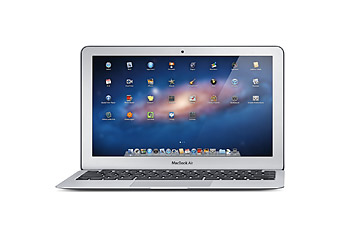
(2 of 2)
AirDrop, a new feature for moving files between nearby Lion-equipped Macs, could end up being one of the operating system's sleeper hits. OS X and Windows have a variety of tools meant to ease the shuttling of files from one computer to another, but none of them compare to AirDrop's obsessive simplicity. You just drag one or more files onto another computer's AirDrop icon in the Finder, whereupon that machine's owner gets an alert and can approve (or reject) the transfer. The two Macs in question don't even have to be on the same network: They use their wi-fi radios to establish a direct, computer-to-computer connection.
OS X already has two extremely useful features that are, by Apple standards, a tad nerdy. Exposé puts thumbnail versions of all open windows on one screen so you can zip between them; Spaces lets you create multiple virtual desktops, handy for organizing apps and reducing clutter. In Lion, they've been melded into something called Mission Control — one screen, accessible by a single key press, that shows all open windows and all Spaces. Clueless newbies might still be intimidated: if you have more than a few apps and Spaces or both open, the screen starts to bulge at the seams with thumbnails of windows and desktops. But anyone who tried these features in the past and didn't bond with them should give Mission Control a chance.
Unlike iPads and iPhones — and certain Windows PCs — Macs don't have touchscreens. In fact, Apple contends that they'd be ergonomic disasters on traditional computers with upright displays. The company does, however, give its Mac portables some of the roomiest touch pads in the business, and it sells touch-enabled Magic Mice as well as a desktop touch pad called the Magic Trackpad. And it's packed Lion with gestures that are reminiscent of the ones in iOS without being identical to them. Slide three fingers to the left or right, for instance, and you segue between full-screen apps and spaces; slide them upward toward the keyboard and you land in Mission Control.
Apple also risked baffling Mac veterans by reversing two long-standing OS X gestures to make them more consistent with iOS. In Lion, you swipe up with two fingers to scroll downward, and down to scroll upward. In past versions, it was the opposite. I was flummoxed by this flip-flop for about half a day — and then forgot that it had ever been different.
Of course, not everyone is going to be smitten with the idea of making Macs more like iOS devices. Even if you're a skeptic, however, Lion packs plenty of improvements. The Mail app, for instance, adds a conversation view that bundles related messages into discussion threads — the basic idea already shows up everywhere from Outlook to Gmail, but Apple's version is the most readable one I've encountered. Search features also get a lot more potent. If you're the type who wants to track down all word-processing files that were created by a particular co-worker and contain specific keywords, you can.
I even discovered that Apple fixed one of my pet peeves without bothering to enumerate it in the 250 new features. Those of us who use iCal to wrangle multiple calendars can finally specify a particular one as the default choice for new appointments. It's nothing that will ever get trumpeted in an ad — but somebody in Cupertino noticed an area for improvement and took action.
Lion's iPad-like gloss on OS X is largely successful, in part, because just about everything that's new is optional. If you're unimpressed with Launchpad or full-screen mode or even the App Store, you can blithely ignore those things. Still, this modernization of the 27-year-old Mac platform goes only so far. Macs still allow you to install programs that haven't been vetted by Apple, some of which are terrific and some of which will crash your computer. They've got file systems crammed with thousands of mysterious folders and files. They require occasional use of nerdy programs like Disk Utility. They can even suffer from security flaws, at least until Apple patches them.
It'll be fascinating to see where the company takes the iPadification of the Mac in future OS X releases and how far it can push it without ticking off consumers who were pretty pleased with Macs the way they were. Also worth keeping tabs on: iCloud, the great universal storage system in the sky that Apple intends to deliver along with iOS 5 this fall. By coordinating the juggling of files of all sorts among Macs, iPads and iPhones, it'll bring all of Apple's gizmos that much closer.
For now, Lion feels, to revive an old OS X tagline, like a new Mac for your Mac. At $129, it would have been a meaty good value. At $29.99, it's a steal — the no-brainer upgrade that defines the notion of a no-brainer upgrade.
McCracken blogs about personal technology at Technologizer, which he founded in 2008 after nearly two decades as a tech journalist; on Twitter, he's @harrymccracken. His column, also called Technologizer, appears every week on TIME.com.
